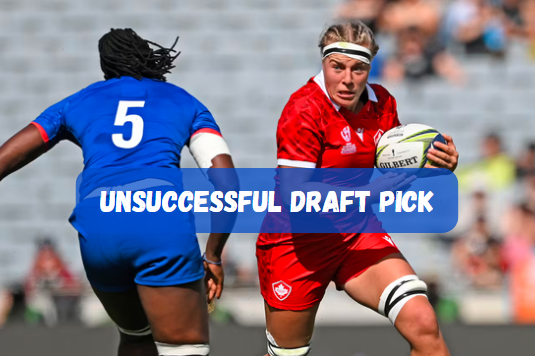Draft picks are pivotal in shaping the future of sports teams, especially in leagues like the NFL, NBA, and MLB. However, not every draft pick pans out as expected. An “unsuccessful draft pick” refers to a player selected in a draft who fails to meet performance expectations or does not contribute significantly to the team’s success.
This comprehensive article delves into the intricacies of unsuccessful draft picks, examining the reasons behind their lack of success, the impact on teams, and notable examples. Additionally, we provide insights and analyses that go beyond existing information, offering a fresh perspective on this critical aspect of sports management.
Contents
- 1 Understanding the Concept of an Unsuccessful Draft Pick
- 2 Factors Contributing to an Unsuccessful Draft Pick
- 3 Impact of Unsuccessful Draft Picks on Teams
- 4 Notable Examples of Unsuccessful Draft Picks
- 5 Strategies to Mitigate the Risk of Unsuccessful Draft Picks
- 6 Frequently Asked Questions (FAQs)
- 7 Conclusion
Understanding the Concept of an Unsuccessful Draft Pick
An unsuccessful draft pick is a player who, despite being selected with high hopes and expectations, fails to live up to the potential envisioned by the team that drafted them. This failure can manifest in various ways, such as poor performance, injuries, off-field issues, or simply not fitting into the team’s system. The disappointment of an unsuccessful draft pick can have far-reaching consequences, affecting team morale, financial investments, and future draft strategies.
The High Stakes of Draft Selections
Draft selections are high-stakes decisions involving extensive scouting, analysis, and projection. Teams invest significant resources in evaluating potential picks, including physical performance metrics, psychological evaluations, and background checks. Despite these efforts, the outcome of a draft pick remains uncertain, and even the most promising prospects can turn into unsuccessful draft picks.
Factors Contributing to an Unsuccessful Draft Pick
Several factors can contribute to a draft pick becoming unsuccessful. Understanding these factors is crucial for teams to refine their scouting and selection processes.
1. Overestimation of Talent
Scouting reports and college performance can sometimes lead to an overestimation of a player’s talent. A player may excel in college but struggle to adapt to the professional level due to differences in competition, speed, and complexity of the game.
2. Injuries
Injuries are a significant risk factor for any athlete. A highly touted draft pick can quickly become an unsuccessful draft pick if they suffer a career-altering injury. The physical demands of professional sports can exacerbate pre-existing conditions or lead to new injuries that hinder performance.
3. Psychological Factors
The mental aspect of transitioning to professional sports is often underestimated. Pressure, stress, and the need to adapt to a new environment can impact a player’s performance. Those unable to cope with these pressures may underperform, contributing to their status as an unsuccessful draft pick.
4. System Fit
Not every player fits seamlessly into every team’s system. A player might be highly talented but fail to perform well if the team’s playing style, coaching, or organizational culture does not align with their strengths and preferences.
5. Off-Field Issues
Off-field behavior, including legal troubles, substance abuse, or personal problems, can derail a promising career. Teams increasingly consider a player’s character and background to avoid such issues, but they remain a risk factor.
6. Developmental Support
The level of support and development opportunities provided by a team can significantly impact a player’s success. A lack of proper coaching, mentoring, or resources can turn a potential star into an unsuccessful draft pick.
Impact of Unsuccessful Draft Picks on Teams
The ramifications of an unsuccessful draft pick extend beyond the player’s individual career. Teams invest heavily in draft picks, and the failure of a high draft pick can have several negative impacts.
1. Financial Losses
High draft picks often come with substantial financial commitments. An unsuccessful draft pick represents a loss on this investment, affecting a team’s salary cap and financial flexibility.
2. Lost Opportunity
Every draft pick represents a lost opportunity to select another potentially successful player. An unsuccessful draft pick means a missed chance to bolster the team’s roster with a valuable contributor.
3. Team Morale and Public Perception
Frequent unsuccessful draft picks can affect team morale and damage the public’s perception of the team’s management. Fans and media scrutiny can add pressure on the organization and its decision-makers.
4. Future Draft Strategy
Teams may become more cautious or overly conservative in future drafts, potentially missing out on high-risk, high-reward players due to the fear of another unsuccessful draft pick.
Notable Examples of Unsuccessful Draft Picks
Examining notable examples of unsuccessful draft picks can provide valuable insights into the common pitfalls and lessons learned.
1. Ryan Leaf (NFL)
Ryan Leaf, the second overall pick in the 1998 NFL Draft, is often cited as one of the biggest draft busts in NFL history. Despite his promising college career, Leaf struggled with poor performance, injuries, and off-field issues, leading to a short and disappointing NFL career.
2. Darko Miličić (NBA)
Selected second overall in the 2003 NBA Draft, Darko Miličić was expected to be a franchise-changing player. However, he failed to develop as anticipated, overshadowed by the success of other players in the same draft class, including LeBron James, Carmelo Anthony, and Dwyane Wade.
3. JaMarcus Russell (NFL)
JaMarcus Russell, the first overall pick in the 2007 NFL Draft, had a brief and underwhelming career with the Oakland Raiders. Issues with work ethic, weight management, and performance led to his release after just three seasons.
Strategies to Mitigate the Risk of Unsuccessful Draft Picks
While the risk of an unsuccessful draft pick can never be entirely eliminated, teams can adopt strategies to mitigate this risk and improve their draft success rate.
1. Comprehensive Scouting and Analysis
Investing in advanced scouting techniques and comprehensive analysis can help teams make more informed decisions. This includes utilizing data analytics, performance metrics, and psychological evaluations to build a complete profile of potential draft picks.
2. Emphasizing Character and Work Ethic
Assessing a player’s character, work ethic, and off-field behavior can help identify those who are more likely to succeed at the professional level. Teams should prioritize players who demonstrate resilience, discipline, and a strong commitment to their sport.
3. Tailoring Development Programs
Providing tailored development programs that address individual players’ needs can enhance their chances of success. This includes personalized coaching, mentoring, and support to help players transition smoothly to the professional level.
4. Managing Expectations
Setting realistic expectations and providing support to manage the pressures of professional sports can help players perform better. Teams should foster an environment that allows players to grow and develop at their own pace.
5. Contingency Planning
Having contingency plans in place for potential unsuccessful draft picks can help teams minimize the impact. This includes having backup options and strategies to address any gaps created by underperforming players.
Frequently Asked Questions (FAQs)
1. What is an unsuccessful draft pick?
An unsuccessful draft pick refers to a player selected in a draft who fails to meet performance expectations or does not contribute significantly to the team’s success.
2. What factors contribute to an unsuccessful draft pick?
Factors contributing to an unsuccessful draft pick include overestimation of talent, injuries, psychological factors, system fit, off-field issues, and lack of developmental support.
3. How do unsuccessful draft picks impact teams?
Unsuccessful draft picks can lead to financial losses, lost opportunities, negative impacts on team morale and public perception, and influence future draft strategies.
4. Can teams prevent unsuccessful draft picks?
While it is impossible to completely prevent unsuccessful draft picks, teams can mitigate the risk through comprehensive scouting, emphasizing character and work ethic, providing tailored development programs, managing expectations, and having contingency plans.
5. What are some notable examples of unsuccessful draft picks?
Notable examples of unsuccessful draft picks include Ryan Leaf (NFL), Darko Miličić (NBA), and JaMarcus Russell (NFL).
Conclusion
Understanding the concept of an unsuccessful draft pick is crucial for sports teams aiming to maximize their draft success. By analyzing the factors contributing to draft failures and implementing strategies to mitigate these risks, teams can improve their selection processes and build stronger rosters.
The impact of an unsuccessful draft pick goes beyond individual performance, affecting team dynamics, financial stability, and future planning. By learning from past mistakes and continuously refining their approach, teams can enhance their chances of making successful draft picks and achieving long-term success.




